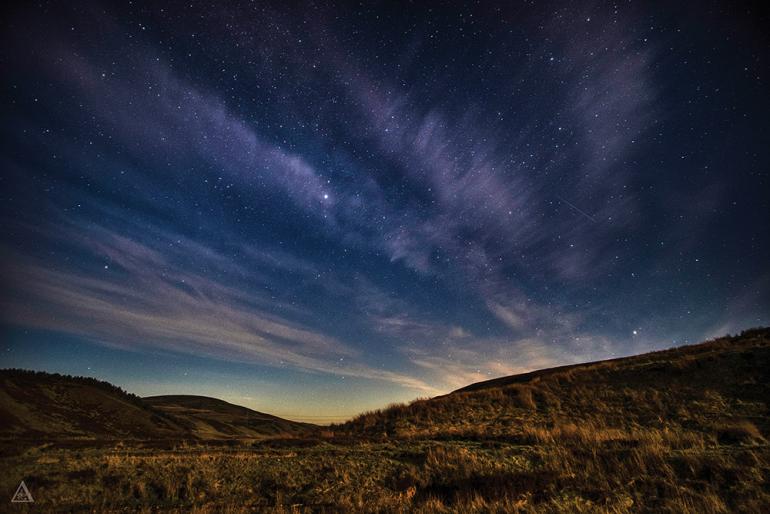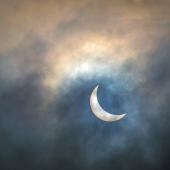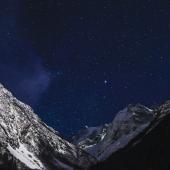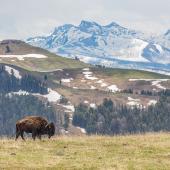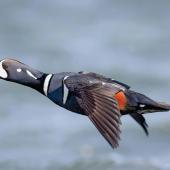Stars & Stripes
What to look for in the night sky.
Summertime is a great time to stargaze. Whether sitting around a crackling campfire or lounging in your own backyard, the nights aren’t going to get any balmier than now. Fortunately, there’s much starriness to see, given that in the old days, practically everything in the sky that wasn’t the moon was considered a “star” of one sort or another.
First, there are the actual “fixed” stars that don’t change their positions relative to each other. (Well, they do, but they’re so far away it takes centuries to notice). Out of them we make the constellations.
For example, this season features the Summer Triangle, made up of three bright stars: Vega (in Lyra the lyre, with its tiny slanted box of stars for strings), Deneb (in the tail of Cygnus the swan or the Northern Cross, which it caps), and Altair (in the diamond shape of Aquila the eagle, the pattern marking its wings). Look for it high in the southeast at nightfall in early summer, then watch it shift westward each night as summer progresses.
Think of it as a giant arrowhead, pointing south to where the teapot shape of Sagittarius the archer sits just above the horizon—east of the fishhook pattern of Scorpius the scorpion.
On a clear dark night, you can also see the starry road of the Milky Way—the edge-on view of our galaxy—rising like clouds of steam from the Teapot up through the Summer Triangle and into the northeast. For some Native American cultures, this was the road to the afterlife, and the bright stars along it, like the Summer Triangle, were the campfires set by souls making the fateful journey.
Second, there are the “wandering” stars—the planets—two of which are nicely placed for late-summer viewing this year. Just east of Sagittarius lies the dim, hammock-shaped pattern of Capricornus the sea goat, and plopped in the middle of it, as if enjoying a rest, is the ringed planet Saturn, the mythical Father Time. It will easily be the brightest “star” in the pattern. Just off the left edge of the hammock is the much brighter Jupiter, king of the gods, positioned as if to give Saturn a little rock-a-bye.
The planets will rise in the southeast around 11:30pm in mid-July. By August 2, Saturn rises at sunset. Jupiter does the same on August 20, and then they’ll be in the sky at nightfall through the fall.
Third, there are “falling” stars to see, most notably the Perseid meteor shower of August—dust shed from Comet Swift-Tuttle, whose debris stream Earth encounters every year at this time. In Christian tradition, these meteors were known as St. Lawrence’s Tears after the saint martyred by the Romans around this date. These bits of comet dust burn up high in the atmosphere, streaking across the sky from the direction of the constellation Perseus, which rises in the northeast around sunset.
This year’s shower peaks around mid-day on August 12, so the best time to look is after midnight in the pre-dawn hours and the following evening. The crescent moon sets swiftly after the sun, so the sky, if clear, will be dark. Find a dark location, stretch out in a lawn chair with your feet aiming northeast, and enjoy the show. If the shower is performing well, you may see 20-40 shooting stars per hour.
Alas, we have no “hairy” stars—comets—on the schedule for summer, as we did last summer with the glorious Comet NEOWISE. But keep your antennae up; there’s a comet named Leonard streaking in toward the sun this year. Although comets are notoriously unpredictable, it just might become visible in binoculars at year’s end, or even just visible to the naked eye. You never know.
And so it is, generally: you never know for sure all that you might see by looking up at the starry night sky. It’s summer; take a look!
Jim Manning is the former executive director of the Astronomical Society of the Pacific. He lives in Bozeman.



